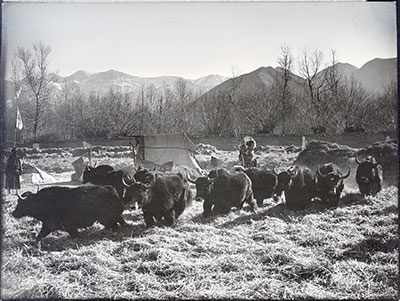
1998.131.198 (Print black & white)


1998.131.198 (Print black & white)

Frederick Spencer Chapman
Frederick Spencer Chapman
November 27th 1936
Lhasa Area
1998.131.198
135 x 178 mm
Harvesting
Print gelatin silver
Donated 1994
Faith Spencer Chapman
British Diplomatic Mission to Lhasa 1936-37
Frederick Spencer Chapman
C.15.4 [view film roll]
SC.T.2.198
BMR.86.1.58.2
Notes on print/mount - "29b" has been written in pencil in the top left hand corner on the back of the print. There are a large number of cropping and proofing marks on the back of the print and these include the instruction "Square up, cut 3/4" from side as indicated and reduce to 5 5/8" across". The cropping would remove the standing figure from the extreme left of the image. The number "C-15-4" has also been written in pencil across the centre of the image. This refers to the numbering system that Chapman used to record images taken on the Mission to Lhasa in 1936-37. There is also a small section of a sticky label that had been attached to the back of the print still visible, although it is not clear what this originally said [MS 17/1/2005]
Manual Catalogues - Caption in Chapman's hand-written list of negatives made whilst on the Mission to Lhasa, 1936-7 [See PRM Manuscripts Collection]: 'Ditto [threshing with yaks]. Yaks nearer a little under [exposed] and moved'; PRM Manuscripts Collection: ‘List of Tibetan Prints and Negatives’ - Book 4: ‘7/4 - Yaks threshing the barley outside Lhasa’ [MS 13/03/2006]
Other Information - Location: This image was probably taken close to the Regent's house as images C.15.2 and C.15.3 identify the location and the house can be seen in the background [MS 13/03/2006]
Other Information - Related Images: Images prefixed with 'C.15.' seem to have been taken over a relatively long period from November 26th to January 7th. This may have been because Chapman was running out of quarter plate film at this point because the only other images he took using this film type appear to have been of the interior of the Norbhu Lingka, the Potala and ceremonies at the Jokhang. However, on December 20th he comments that "something is wrong with the 1/4 plate camera" [1938: 294], which may have influenced his use of it. Images with prefix 'C.15' comprise a group of negatives containing images of threshing barley, Regent’s house, ferry near Dekyi Lingka and panoramic views of environs, mummers, Norbu Lingka, paper chase, tea at football match, Everest permit, Khampa people. This collection of images is headed with the title of ‘Rural Pursuits’ and it seems that Chapman may originally have intended to use this box of negatives whilst seeking out scenes such as threshing barley. However, this objective seems to have passed as the negatives were used, as a wider variety of images than this title suggests were taken. This may also reflect the limitations of access to such scenes in and around the mission compound in the Dekyi Lingka and the constraints upon the photographic agenda of the mission [MS 13/03/2006]
Other Information - Cultural Background: Typically barley would be harvested in central Tibet in the late Autumn. The wall in the background, in this case, would be the wall surrounding the Snake Temple on the north side of the Potala. Chapman wrote in his book Lhasa the Holy City [London: Chatto & Windus, 1938; reprint, London: Readers Union Ltd., 1940]: "The Ling-kor follows the wall of the Snake Temple and of the flooded reed-covered enclosure alongside. ... The Sacred Way now crosses some open barley-fields where they are gathering in the harvest and treading out the corn with the aid of a dozen or fifteen yaks, which they drive round and round over a floor of beaten clay. On one side is a pile of grain protected from evil spirits by a brightly coloured prayer-flag. Women are sifting the grain and sorting it by tossing it in basket-work trays, and storing it in striped brown and white yak-hair bags. It has been a good harvest. Luckily there were no hail-storms when the grain was ripening, nor any night frosts. An early drop in the temperature can lay waste acres of barley, though these frosts are unusual in the sheltered and comparatively low-lying vale of Lhasa. Now they are starting to plough up the fields with yaks and dzos harnessed in pairs. This must be finished before the ground is held by the winter frosts" [1940, p.165] [MS 12/3/2005]
Other Information - Cultural Background: This is the last stage in the process of harvesting barley. After threshing the crop the yaks walk repeatedly over the barley to ensure that all the grains are removed from the stalks. Afterwards the remaining stalks are used as fodder. [TS 20/1/2005]
For Citation use:
The Tibet Album.
"Yaks treading out barley outside Lhasa"
05 Dec. 2006. The Pitt Rivers Museum.
<http://tibet.prm.ox.ac.uk/photo_1998.131.198.html>.
For more information about photographic usage or to order prints, please visit the The Pitt Rivers Museum.
© The Pitt Rivers Museum